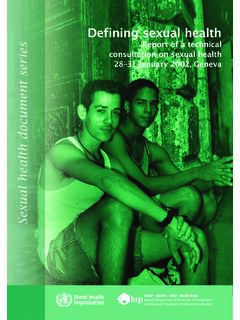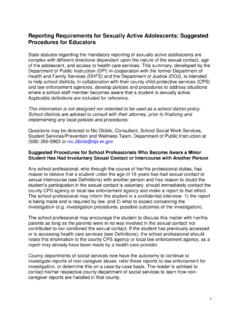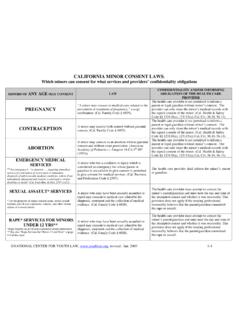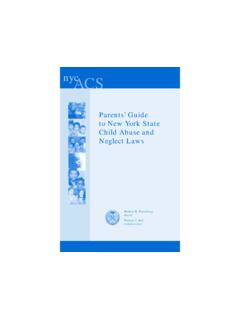Transcription of 7 Child sexual abuse
1 757 Child sexual abuseSUMMARY The dynamics of Child sexual abuse differ from those of adult sexual abuse . In particular,children rarely disclose sexual abuse immediately after the event. Moreover, disclosure tends tobe a process rather than a single episode and is often initiated following a physical complaint ora change in behaviour. The evaluation of children requires special skills and techniques in history taking, forensicinterviewing and examination; the examiner may also need to address specific issues related toconsent and reporting of Child sexual abuse .
2 Definitive signs of genital trauma are seldom seen in cases of Child sexual abuse , as physicalforce is rarely involved. The accurate interpretation of genital findings in children requires specialisttraining and wherever possible, experts in this field should be consulted. Decisions about STI testing in children should be made on a case-by-case basis. If testing iswarranted, age-appropriate diagnostic tests should be used. Presumptive treatment of childrenfor STIs is not generally recommended. A follow-up consultation is strongly recommended.
3 Although a physical examination may notbe necessary, a follow-up consultation provides an opportunity to assess any psychologicalproblems that may have since arisen and to ensure that the Child and his/her caregiver arereceiving adequate social support and Definition of Child sexual abuseThese guidelines adopt the definition of Child sexual abuse formulated by the1999 WHO Consultation on Child abuse Prevention (62) which stated that: Child sexual abuse is the involvement of a Child in sexual activity that he orshe does not fully comprehend, is unable to give informed consent to, or forwhich the Child is not developmentally prepared and cannot give consent, orthat violates the laws or social taboos of society.
4 Child sexual abuse is evidencedby this activity between a Child and an adult or another Child who by age ordevelopment is in a relationship of responsibility, trust or power, the activitybeing intended to gratify or satisfy the needs of the other person. This mayinclude but is not limited to: the inducement or coercion of a Child to engage in any unlawful sexualactivity; the exploitative use of a Child in prostitution or other unlawful sexualpractices; the exploitative use of children in pornographic performance andmaterials.
5 GUIDELINES FOR MEDICO-LEGAL CARE FOR VICTIMS OF sexual Dynamics of Child sexual abuseThe sexual abuse of children is a unique phenomenon; the dynamics are oftenverydifferent to that of adult sexual abuse and therefore abuse of this naturecannotbehandledin the same way (38, 63 65). Features that characterize childsexual abuse include: Physical force/violence is very rarely used; rather the perpetrator tries tomanipulate the Child s trust and hide the abuse . The perpetrator is typically a known and trusted caregiver.
6 Child sexual abuse often occurs over many weeks or even years. The sexual abuse of children frequently occurs as repeated episodes thatbecome more invasive with time. Perpetrators usually engage the Child in agradual process of sexualizing the relationship over time ( grooming). Incest/intrafamilial abuse accounts for about one third of all Child sexualabuse are individuals who prefer sexual contact with children to are usually skilled at planning and executing strategies to involvethemselves with children.
7 There is evidence to suggest that paedophiles mayshare their information about children ( Child pornography). This can occurat an international level, particularly through the use of the training in the dynamics of Child sexual abuse is essential for health care professionals to ensurethat potential harm to children and their families is avoided by missing a diagnosis or by Risk factors for victimizationA number of factors that make individual children vulnerable to sexual abusehave been identified.
8 Although based largely on experience in North Americancountries, the key determinants are believed to be (63, 66): female sex (though in some developing countries male children constitutea large proportion of Child victims); unaccompanied children; children in foster care, adopted children, stepchildren; physically or mentally handicapped children; history of past abuse ; poverty; war/armed conflict; psychological or cognitive vulnerability; single parent homes/broken homes; social isolation ( lacking an emotional support network); parent(s) with mental illness, or alcohol or drug Dynamics of disclosureIn the majority of cases, children do not disclose abuse immediately followingthe event.
9 The reluctance to disclose abuse tends to stem from a fear of the77perpetrator; the perpetrator may have made threats, such as If you tell anyoneI will kill you/ kill your mother (66 69).The Child sexual abuse accommodation syndrome , proposed by Summit(69), has been invoked by a number of researchers to explain why children sdisclosures are often delayed following abuse and why disclosure is sometimesproblematic or retracted. According to its author, the typical pattern of eventsis as follows: the Child is forced to keep the sexual abuse a secret and initiallyfeels trapped and helpless.
10 These feelings of helplessness and the Child s fearthat no one will believe the disclosure of abuse lead to accommodativebehaviour. If the Child does disclose, failure of family and professionals toprotect and support the Child adequately, augment the Child s distress andmay lead to retraction of the disclosure (69).Disclosure of sexual abuse in children can be purposeful or accidental ( intended or not intended by the Child or perpetrator). Disclosure isoften initiated after an enquiry about a physical complaint, for example, painwhen washing the genital area or a bloodstain in the panties.


















